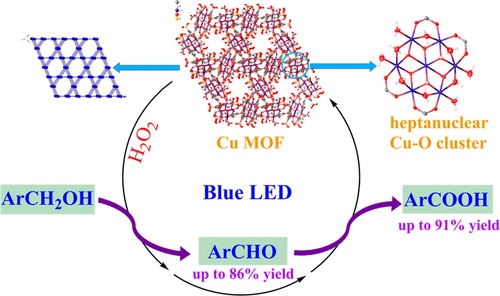陈旭东教授课题组在INORGANIC CHEMISTRY发表研究论文
Metal-Organic Framework Based on Heptanuclear Cu-O Clusters and Its Application as a Recyclable Photocatalyst for Stepwise Selective Catalysis
Zhou, J (Zhou, Jie)[ 1,2 ] ; Xu, HF (Xu Huang-Fu)[ 1,2 ] ; Huang, YY (Huang, Yang-Ying)[ 1,2 ] ; Cao, CN (Cao, Chu-Ning)[ 1,2 ] ; Han, J (Han, Jie)[ 3 ] ; Zhao, XL (Zhao, Xiao-Li)[ 4 ]*; Chen, XD (Chen, Xu-Dong)[ 1,2 ]*(陈旭东)
[ 1 ] Nanjing Normal Univ, Jiangsu Key Lab Biofunct Mat, Sch Chem & Mat Sci, Nanjing 210023, Peoples R China
[ 2 ] Nanjing Normal Univ, Jiangsu Collaborat Innovat Ctr Biomed Funct Mat, Sch Chem & Mat Sci, Nanjing 210023, Peoples R China
[ 3 ] Open Univ Hong Kong, Sch Sci & Technol, Kowloon, Hong Kong, Peoples R China
[ 4 ] East China Normal Univ, Dept Chem, Shanghai Key Lab Green Chem & Chem Proc, Shanghai 200062, Peoples R China
INORGANIC CHEMISTRY,202001,59(1),254-263
Visible-light driven photoreactions using metal-organic frameworks (MOFs) as catalysts are promising with regard to their environmental friendly features such as the use of renewable and sustainable energy of visible light and potential catalyst recyclability. To develop potential heterogeneous photocatalysts, a family of three copper(II) coordination polymers bearing different Cu-O assemblies have been synthesized with the ligand 4,4'-disulfo-[1,1'-biphenyl]-2,2'-dicarboxylate acid (H4DSDC), namely, {[Cu-7(DSDC)(2)(OH)(6)(H2O)(10)]center dot xH(2)O}(n) (1), {[Cu-4(DSDC)(4,4'-bpy)(2)(OH)(4)]center dot 2H(2)O}(n) (2), and (Cu-2(DSDC)(phen)(2)(H2O)(2)}(n) (3) (4,4'-bpy = 4,4'-bipyridine and phen = 1,10-phenanthroline). Complex 1 represents a metal-organic framework featuring a NbO type topology constructed from the infinite linkage of heptanuclear [Cu-7(mu(3)-OH)(6)(H2O)(10)](8+) clusters by deprotonated DSDC4- ligands, comprising one-dimensional hexagonal channels of a diameter around 11 angstrom that are filled with water molecules. The infinite waving {[Cu-2(OH)(2)](2+)}(n) ladderlike chains in complex 2 are bridged by DSDC4- and 4,4'-bpy ligands into a three-dimensional framework. A two-dimensional layered structure is formed in complex 3 due to the existence of terminal phenanthroline ligands. All of the coordination polymers 1-3 are able to catalyze the visible-light driven oxidation of alcohols at mild conditions using hydrogen peroxide as an oxidant, in which complex 1 demonstrates satisfactory efficiency. Significantly for this photoreaction catalyzed by 1, the extent of oxidation over aryl primary alcohols is fully controllable with time-resolved product selectivity, giving either corresponding aldehydes or carboxylate acids in good yields. It is also remarkable that the photocatalyst could be recovered almost quantitatively on completion of the catalytic cycle without any structure change, and could be recycled for catalytic use for at least five cycles with constant efficiency. This photocatalyst with time-resolved selectivity for different products may provide new insight into the design and development of novel catalytic systems.

文章链接:
https://pubs.acs.org/doi/abs/10.1021/acs.inorgchem.9b02084
版权与免责声明:本网页的内容由收集互联网上公开发布的信息整理获得。目的在于传递信息及分享,并不意味着赞同其观点或证实其真实性,也不构成其他建议。仅提供交流平台,不为其版权负责。如涉及侵权,请联系我们及时修改或删除。邮箱:sales@allpeptide.com